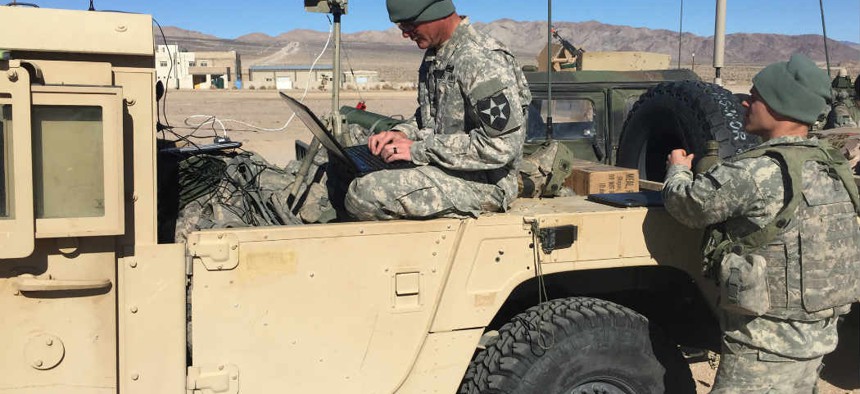Lessons learned from training Army combat units in cyber ops
The Cyber Electromagnetic Activities pilot initiative focused on equipping tactical commanders and brigades with cyber and information operation techniques.
What started as an Army Cyber Command-led initiative to train tactical units in offensive cyber operations has blossomed into all-encompassing collaboration focused on operationalizing cyber warfare on the front lines.
But, officially, no such thing exists.
The Cyber Electromagnetic Activities Support to Corps and Below pilot program launched in 2015 and wrapped up its first phase in September. At the Association of the U.S. Army's "hot topic" event on cyber operations and the future fight Wednesday, Army Cyber leaders reflected on the program and how it can be made even more trainable and scalable across the entire force.
"It was a lot harder to do this in the operational environment than it was to do a PowerPoint slide," Col. William J. Hartman, U.S. Army Cyber Command's deputy commander for Joint Force headquarters joked during his AUSA panel on the CEMA program.
"You have to be able to do this in the middle of a monsoon in Polk, La., or any other operational area," he added. "You have to be able to do this when it's 118 degrees and the wind is blowing 70 miles an hour."
Hartman noted that effective communication between cyber and tactical teams is a surmountable challenge. But to be successful at the tactical level, cyber teams must be able to talk about techniques and capabilities in maneuver terms.
"There was a lack of knowledge" from a cyber and operational standpoint on how to integrate with the operational force, which included light infantry airborne, armor and Stryker brigade combat teams.
So far, the CEMA pilot program, which produced expeditionary cyber teams, has participated in eight different rotations where cyber and brigade combat teams train together for six months.
"If the unit is doing a field exercise from Ft. Riley, we go through the field exercise with them," Hartman said. "We go through any of their battle command training exercises. We participate in their leadership training program that they go through prior to going through prior to going to a combat training center rotation."
"But right now, expeditionary cyber teams don't exist in the Army," Hartman said. He said there were elements of the teams being used worldwide with U.S. allies, but declined to give specifics.
"We formed these teams for specific purposes based on requirements. So whether it's going to support a lightning force exercise in Korea or Hawaii, or whether it's going to support a national training exercise or go into [Joint Readiness Training Center] with the S5s. We bring in these soldiers and civilians from across the formation and they stay together for the duration of this thing," Hartman told reporters following the event.
The ECT teams – typically comprised of fewer than 10 people including defensive and offensive cyber operators, planners, and electronic warfare soldiers -- help address specific directives tailored to what skills and capabilities combat commanders need soldiers to have.
"When you look at the Army's mission of attack and destroy, not everything is 'destroy,' [it's] how can I influence" the adversaries, said Col. Robert Ryan, who commands the 3rd Brigade Combat Team, 25th Infantry Division in Hawaii and has participated in the pilot. "How can I non-kinetically reach up and create confusion and gain control…I don't have to always render [adversaries] neutral in the sense of death but I can influence them in other ways."
But all of this is still experimental and there's no hard timeline on when that will change.
Hartman said CEMA was initially slated for two years but they expect to continue doing three rotations a year, tying them into other initiatives.
Additionally, the Army is still working on how to structure and best integrate the cyber electromagnetic activities at the corps, division, and brigade levels.
"The demand [for information] isn't going down across society," said Ryan, who mentioned ECT teams increase his soldiers' ability to conduct operations. "It'll be interesting to see how we can leverage that information highway."
NEXT STORY: Modernization in Defense






